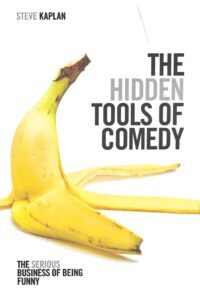Kaplan Writes Funny

Steve Kaplan. 2013. The Hidden Tools of Comedy: The Serious Business of Being Funny. Studio City, CA: Michael Wiese Productions.
Review by Stephen W. Hiemstra
Comedy is one of the building blocks of fiction. Much like you learn to write sentences and paragraphs in a writing class, comedy has structure and logic even if it is not obvious to a reader. Not every character is comedic, but neither do all characters play life straight. We recognize the jester in every office as much as the bully or the jerk. Why then is it so hard to find good books on building comedy into your stories?
Introduction
The introduction to Steve Kaplan’s The Hidden Tools of Comedy: The Serious Business of Being Funny includes this purpose statement:
“While there were books on how to be a stand-up comic, or on improvisation or theater games, there were few books that offered serious analysis of comic theory and its practical application for writers, directors, and actors.” (xvii)
Kaplan focuses on tools to fix problem in writing comedy when something just doesn’t click (xix).
Background and Organization
Steve Kaplan has a Bachelor’s degree from Hofstra University in Hempstead, New York and a masters degree from California State University in Northridge, CA. He is widely known as an educator and consultant and has a second book on comedy: The Comic Hero’s Journey: Serious Story Structure for Fabulously Funny Films (2018).
Kaplan writes in fourteen chapters divided into three parts:
PART 1: UNDERSTANDING COMEDY
The myths of comedy
The comedy perception test
The answer (theory of comedy)
The comic equation
Introducing the tools
PART 2: THE HIDDEN TOOLS OF COMEDY
Tool 1: Winning
Tool 2: Non-hero
Tool 3: Metaphorical relationships
Tool 4: Positive action
Tool 5: Active emotion
Tool 6: Straight line/wavy line
Tool 7: Archetypes or commedia tonight
Tool 8: Comic premise
PART 3: THE PUNCH LINE
Comedy F.A.Q. (ix-x)
These chapters are proceeded by introduction and reading guide, and followed by an afterword, acknowledgments, and an about the author.
What is Comedy?
The book focuses on unpacking Kaplan’s definition of comedy:
“Comedy is about an ordinary guy or gal struggling against insurmountable odds without many of the required skills and tools with which to win yet never giving up hope.” (27)
The reason for the focus on this definition is that Kaplan is not explaining how to tell a joke. He is focused on comedy in the context of television and film writing where the comedy bounces from scene to scene over time and must carry the audience along.
Because the audience identifies with non-heroic characters, the comedic element arises organically. Jokes and quips only make sense when they advance the plot. The laughs arise as the non-hero struggles and fails, but does not give up. It’s like when I started jogging again after a 30-year hiatus and an old lady with her dog walked past me as I jogged slowly down the road. I wasn’t even whistling Eye of the Tiger, but my wife and kids thought it was a hoot. Yet, it was a story, not a joke.
Kaplan compares comedy with drama. He writes: “Drama helps us dream about what we could be, but comedy helps us live with who we are.” (20) He describes a soap opera where an unnaturally handsome guy talks with an unbelievably beautiful woman with a low-cut dress without checking out her cleavage. How natural is that? If he only looks in her eyes—it’s drama. If he peeks at the cleavage—it’s comedy (18-19). In that sense, comedy tells the truth (21).
Assessment
Steve Kaplan The Hidden Tools of Comedy should be in every author’s library. Screenwriters should take special note.
Some aspects, like the comedic premise (the one magical assumption like time travel), drive classic comedies, but also help move many dramas forward. What if the woman falsely driven out of town for adultery came back thirty years later a billionaire? Would she exact her revenge? How would that work? Her revenge need not evoke comedy—it could be legalized, cold-blooded murder (Dürrenmatt).
Kaplan’s work is educational, but it is also fun. He does a good job of using scenes from famous films to illustrate his points. And he tells more than a few jokes.
References
Friedrich Dürrenmatt. 1957. Der Besuch der Alten Dame. [The Visit of the Old Woman] Boston: Houghton Mifflin Company.
Kaplan Writes Funny
Also see:
The Face of God in the Parables
The Who Question
Preface to a Life in Tension
Other ways to engage online:
Author site: http://www.StephenWHiemstra.net
Publisher site: http://www.T2Pneuma.com
Newsletter at: https://bit.ly/East_Apr2024 , Signup
The post Kaplan Writes Funny appeared first on T2Pneuma.net.



